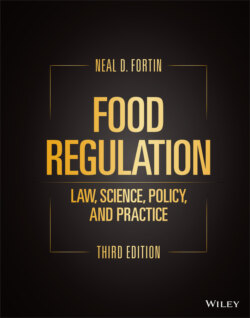Читать книгу Food Regulation - Neal D. Fortin - Страница 60
NOTE
Оглавление1 1.5 USDA FSIS Nets Catfish. The FDA has regulatory jurisdiction over all fish, except catfish. Provisions of the 2008 and 2014 Farm Bills amended the FMIA to define “catfish” as an “amenable species,” making is subject to mandatory inspection by USDA Food Safety Inspection Service (FSIS). Confusing? The legislation transferring jurisdiction purportedly was to ensure safety. However, the Government Accountability Office (GAO) criticized the transfer of jurisdiction over catfish to USDA and the creation of a catfish office in the USDA as one of the government’s most wasteful and duplicative programs. In addition, this transfer to USDA has been criticized as a disguised trade barrier, which raises World Trade Organization (WTO) issues. GAO, SEAFOOD SAFETY: RESPONSIBILITY FOR INSPECTING CATFISH SHOULD NOT BE ASSIGNED TO USDA (May 2012).
Other agencies and units become involved with food in some way as well. For example, the USDA has a number of programs that, while nonregulatory by nature, can affect food regulation. The USDA AMS provides voluntary standardization, grading, and market news services for specific agricultural commodities. The Agricultural Research Service (ARS) is the main scientific research arm of USDA. The USDA Economic Research Service (ERS) provides economic analysis relating to agriculture, food, the environment, and rural development. The USDA Grain Inspection, Packers, and Stockyards Administration (GIPSA) provides grading and standardization programs for grains and related products and regulates and maintains fair trade practices in the marketing of livestock.
The U.S. Codex Office is the point of contact in the United States for the Codex Alimentarius Commission and its activities. The Department of Commerce, National Marine Fisheries Service (NMFS), provides voluntary inspection and certification of fish operations, and administers grades and standards for fish and fish products (similar to the AMS grading and standards programs).
These food regulatory agencies also work with other government agencies when there are crossover responsibilities. For example, FDA works with the Consumer Product Safety Commission to enforce the Poison Prevention Packaging Act. FDA and USDA work with the FBI to enforce the Federal Anti‐Tampering Act, the Department of Transportation to enforce the Sanitary Food Transportation Act, and the U.S. Postal Service to enforce laws against mail fraud.
This federal delegation and organization of responsibilities is somewhat a haphazard patchwork. Just as the statutes were written to address specific problems at particular points in history, the delegation of food regulation was developed to address specific concerns. The delegation, therefore, represents an evolution rather than an organization by design.
A number of authors have called for an end to this patchwork system by creation of a unified food safety agency with paramount responsibility for the safety of the U.S. food supply.51 Similarly, when large outbreaks of foodborne illnesses become public concerns, attention focuses on the organization of food safety regulation.
